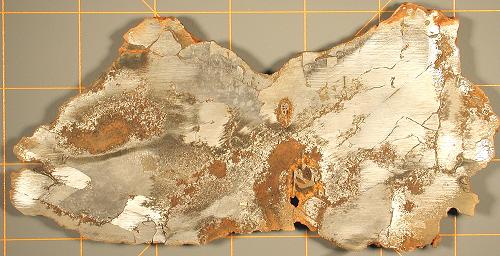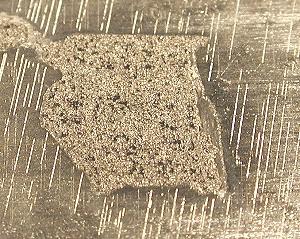
November, 2000

Lab Photo Homepage
Lake Murray
Restoration and Preservation Images

Lake Murray is an iron meteorite, IIB, of extreme terrestrial age, found in Carter County, Oklahoma USA. It was embedded in an undisturbed sandstone sediment deposited 110 million years ago. Over 1000 lbs. of oxidized iron shale was found around the remaining 600 lb. weathered mass.
In February, 2000 we were requested to restore and stabilize an oxidized slice of this rare meteorite. Upon receipt it was obvious that it was in poor condition. The kamacite grain boundaries and troilite nodules were severely oxidized. Left unchecked, oxidation can corrode completely through the lamellae resulting in the breakup of the specimen
After two weeks of flushing and dissolving the contaminants the 520 gram specimen was refinished, polished, and lightly etched.

Nine months later, the specimen seems to be stable with no serious oxides forming.

Neumann lines around a Schreibersite inclusion. Rarely are Neumann lines seen in the kamacite fields of Lake Murray.
A note of caution
Flushing and neutralizing contaminants in iron meteorites is not chemically difficult. It is, however, chemically hazardous. An iron meteorite immersed in a heated anhydrous solution in an ultrasonic tank can be a recipe for disaster. Sound lab procedures and safety protocols must be adhered to.
The restoration and preservation of an iron or stony-iron (pallasite) meteorite is usually not costly. Please contact us for details if you have a need for these services.This document maintained by
staff@meteorlab.com.
Material
Copyright © 2000 New England Meteoritical Services. Index